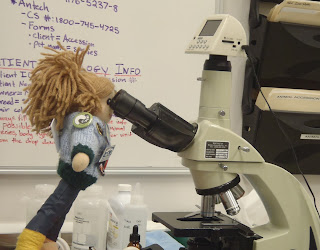I've been rushing around California, trying to visit everyone and it's been crazy ...but so much fun! I got to go back to the California Science Centre (CSS) seeing as I only got to meet the divers last time and this time, I felt like a CSI (Crime Scene Investigator) because I got to look for parasites on fish with the vet staff!
If a fish starts to act funny (like not eating or swimming weirdly) the aquarists alert the veterinary staff and everybody keeps a close eye on it. If necessary, they take the fish out and do a skin scraping (this doesn't hurt the fish, it just takes a bit of slime off their body) to check if there is a parasite that might be making the fish sick. Luckily, we found that the fish is healthy and when I left, it was swimming around just fine.
I also got to check out the quarantine facility where new fish are kept. These fish are kept here for a while, away from display animals to make sure that they don't bring any diseases into the aquarium. This is where I got to see my first California Sheephead:
 |
| Yup, a Sheephead is a fish! |
 |
| Here's a full body shot so that you can see what he looks like. Photo: M Kjaergaard |
 |
| Such a good looking crab! |
The staff then decided to have a laugh and make it look like I was going to have an operation (I was quite glad that the scalpel/knife didn't get any closer! : )):
 |
| The cone over my head is how they give anaesthetic (make them go to sleep for a while) to animals like otters. |
I then quickly got to check out the Hornsharks
and the Kelp Tank before I had to rush off to my next destination on my global travels.
Fascinating stuff once again and next I get to see the Cabrillo Marine Aquarium so keep your eyes peeled for the next blog Sea Fans!
Chat soon.
Cheers
Abby
}( *)8

































